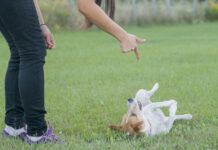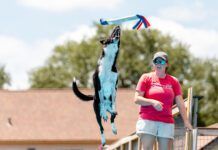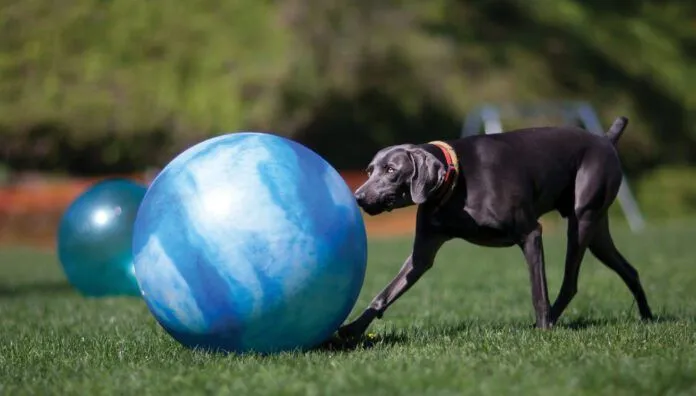
Just when you think every possible canine sport has already been invented, someone comes up with a new one. This latest one is a humdinger, and it’s spreading like wildfire. If you haven’t already heard of treibball (pronounced “Try-ball” and also known as “Drive Ball”), you’ve been napping.
Treibball is a terrific new way to play with your dog. The game consists of “herding” a number of large inflatable exercise balls into a soccer-like net. Of course the herding breeds come to mind, but it’s also great for many of the prey-oriented sporting dogs and terriers, and any other dogs who just like to chase things.
It’s a competitive sport for dogs of all ages and sizes. It promotes better teamwork and communication between a dog and his handler. It’s great fun for any energetic dogs who work well off-leash and need a job, dogs who like to chase stuff, or dogs who like to herd and don’t have sheep!
Treibball was developed by January Nijboer in Germany (“treibball” is variously translated from German as “blowing ball,” “drifting ball,” or “propelling ball”) as a game that would occupy herding dogs. Examples of treibball dogs in action aired a few months ago on YouTube and before you could say “Go bye!” the game went viral in the American dog training world – for good reason. A “flock” of exercise balls makes an inexpensive substitute for a flock of sheep, and doesn’t violate your neighborhood association’s rules, either.
How to Play Treibball
Here are some of the basics of the actual competition:
– The playing field is 100 to 164 feet long, and 50 to 82 feet wide.
– The ball in play must stay within the boundaries of the playing area on the field.
– Eight balls are placed in a triangle (four in the first row, three in the second, one in the third) sort of like racked billiard balls.
– The goal is a regular soccer goal or similar pen – 8 feet high by 24 feet wide.
– Dog and handler have 15 minutes to drive all the balls into the goal. Timing starts when the handler signals the outrun (sending the dog out and around behind the balls) and stops when all the balls are in the goal and the dog is lying down in front of the handler. The dog must do an outrun beyond the balls, stop and pause, and wait for the handler’s cue before beginning to drive the balls.
– The handler must stay within an 18-foot radius from the center of the goal. The handler may not move the ball when it is outside the handler’s area.
– The dog may not bite or break the ball.
– Handlers may not shout at, punish, intimidate, or otherwise force the dog to perform. (We love this about the sport!)
– The fastest team with the fewest error points wins.
How to Train Treibball
As with many canine sports, you can train your dog to play without actually ever competing in treibball. You may not be that competitive or, because it is such a new sport, it may be a while before a trial comes to a neighborhood near you. But that shouldn’t stop you from having a great deal of fun teaching your dog to push big colored balls around your yard all on your own, or with the help of a trainer who offers treibball classes. If you are competitive, you’ll be ready to roll when a trial does pop up in your area.
The ability to control your dog’s position, movement, and speed is a very important element of any type of herding, whether the goal is herding live sheep or big colored balls. Hence, there are a number of skills your dog needs to perfect before he gets to start chasing balls around the yard. We’ll give you an overview of some of the skills your dog will need to learn, but for a deeper understanding of the game you’ll need a book and/or a trainer.
– The outrun: The goal behavior for the outrun is to have your dog run to a target placed 15 feet away, turn to face you, lie down, and wait for your signal to begin driving the ball. As in herding, the term “Go bye” indicates a clockwise outrun (remember, “as time goes by . . .”) and “Away” means a counter-clockwise outrun.
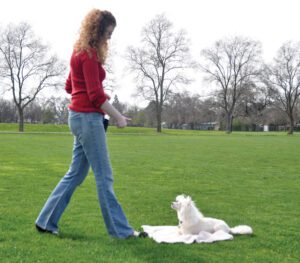
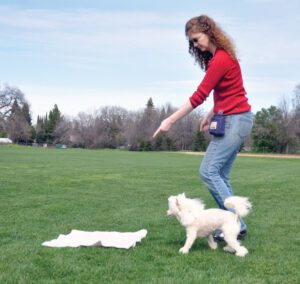
Start by facing a 2-foot square target mat about 6 inches away from you. (Eventually you will reduce the size of the target mat until your dog no longer needs it.) Shape your dog to go to the mat by using a clicker (or other signal, such as a “thumbs up!” or a verbal “Yes!”) and giving your dog a treat each time he makes a movement toward the mat. (For more about shaping, see “The Shape of Things to Come,” WDJ March 2006.)
If you and your dog already know how to shape, teaching him to go to a mat will come very easily. When your dog will reliably offer to move 6 inches to the target, start cuing him to lie down when he gets there. Note: Although you’re clicking and treating for the beginning of this part of the training, the sooner you introduce and the more you rely on toys and play as reinforcers, the more successful your training is likely to be.
When he goes to the mat several times in succession and lies down without you having to cue him, back up another 6 inches and continue. Increase the distance that you ask him to target toward in 6-inch increments (or even smaller increments, if your dog has trouble with 6 inches), obtaining consistency at each distance until the mat is 3 feet away. Note: It’s tempting to move at greater distance increments. Resist the temptation. If you move too far away too quickly, you will confuse your dog and lose ground. Slow and steady is better.
– Now you can start working on signaling the “Go bye” outrun. With your dog on your left side, step forward on your left foot and use an underhanded bowling motion to signal your dog to move to the mat. Don’t say anything yet! Stand with your foot forward and your hand extended until your dog moves to the mat. Click and treat. Repeat until your dog moves immediately and confidently to the mat and lies down when you signal the outrun.
Now add your “Go bye!” cue, just before you signal with your step and hand motion. When he’s consistently confident about moving to the mat at 3 feet on your verbal cue, start increasing distance again, in 6-inch increments. Sometimes cue verbally, sometimes signal; it’s nice to be able to use either or both.
– Next, you’ll work on your “Away” outrun. To prepare for this, do some foundation work to teach your dog to walk (and work) on your right side. These days more trainers recognize the importance of this side-versatility for a number of canine activities including freestyle and agility; it’s great if you’ve already done this. If not, get started – the same way you taught your dog to walk and work on the left side – by reinforcing him for being there.
Ultimately, you’ll want to teach your dog a cue that will position him to the desired side. I use “Swing” for the left, and “Right” for the right. You can use any cues you want, as long as they are different from all the other cues you use with your dog, and you teach him what they mean.
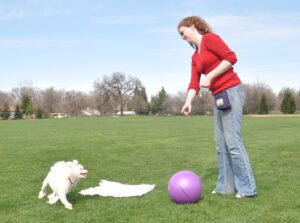
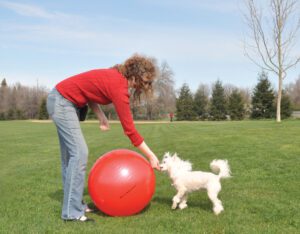
Add the Ball
My students were somewhat surprised – and I suspect a little disappointed – that we weren’t romping around with balls the first night of treibball class. In fact, it was at least the third week before we brought out one hard plastic Jolly Ball per dog, and we still didn’t play with it. When you first introduce the ball, your goal is to get your dog to run past it to his target mat – without attacking the ball. If you’re working with a dog who loves balls, this could be a challenge.
We start with Jolly Balls because if your dog does hit them, they don’t bounce around like inflated exercise balls (thus inciting more inappropriate, aroused behavior). Also, Jolly Balls don’t pop if your dog bites them – which could be highly reinforcing for some dogs or highly aversive for others. We don’t want either outcome; if your dog is reinforced for biting/popping balls (disqualification, not to mention costly!) he’ll do it more. If a popping ball is very aversive to him, he may decline to play treibball with you ever again.
Start with a small Jolly Ball, and reduce your distance to the target mat, setting the ball far off to the side, if necessary, until your dog will refocus on you and go lie down on his mat when you signal him to do so, even in the presence of the beloved ball. You may find it necessary to do some gentle body blocking if he veers toward the ball. If gentle body blocking doesn’t prevent him from moving toward the ball, you’re not ready to add the ball – your dog needs more control work first. Add a “distance down,” “moving down,” and a solid “stay” to your dog’s repertoire while you continue to practice your outrun cues past distractions that are less enticing to your dog than an actual ball.
When your dog will outrun past a ball, you can gradually increase distance to the target mat and move the ball closer a bit at a time, until he will run directly past the ball and lie down on his target mat at your signal to do so. Now try a slightly larger ball. If a larger ball distracts him, again decrease distance to the mat and move the ball off to the side. Repeat this process each time you change the ball to a larger size. Then do it with multiple balls.
Drive the Ball
In order to successfully drive the ball, your dog needs to stay on the side of the ball directly opposite you, so that any contact with the ball moves it in your direction. Stand on one side of the ball, toes pointed toward the ball, with your dog on the other side. Click, and feed him the treat at the correct spot – directly opposite you. Now toss a treat behind him to get him to move away from the ball, and click as he returns toward you, again feeding the treat in the correct spot.
Repeat until you see him automatically lining himself up across from you, then try taking a small step to the left or right, around the ball, keeping your toes toward the ball. If he counters your move to stay across from you, click and treat in the correct spot and pat yourself on the back! If not, help him with a body language cue, then mark and reward when he moves into position. Repeat a couple of the simple direct approaches he already knows, then try another small step to the side.
Continue this until you see him automatically move into position when you take one step around the ball. Then you’re ready for two steps, eventually working up to random movements around the ball. Remember – toes toward the ball!
When your foundation control behaviors are in place, you’re ready to start interacting with the ball. Ideally, your dog will move the ball with his nose, although driving with paws, chest, and shoulders is also allowed. Encourage him to push the ball with his nose by first teaching him to “target” to dots that you paste or paint on the ball, or yellow sticky notes, if he needs a bigger target. (For more about target training, see “Right On Target,” February 2006.)
Hold the ball between your knees (sitting or standing) until he’s targeting to it with sufficient energy that he would easily move the ball at least a few feet if it were on the ground. The ideal target spot is just below the midline of the ball. It works best and minimizes biting of the ball (a no-no!) if you teach him to target to some other object first, then apply it to the ball. (See “New Tricks for a Stick,” January 2007).
When he’s targeting the ball between your knees with some force, place the ball on the ground, take a couple of steps back, and cue him to touch it. Bam! You’re treibballing! Actually, you’ve only just begun, but it’s an excellent start. Still on the training agenda are:
Perfecting the Drive:
– Increasing distance between you and the ball
– Increasing distance between the dog and the ball
– Increasing distance the dog moves the ball
– Increasing speed of ball movement
– Working with multiple balls
– Calling the dog off the wrong ball
– Teaching “Go bye” and “Away” from a distance
– Fading prompts
– Training “Go on” (moving beyond target mats)
– Using whistle cues
– Adding the goal (penning)
Treibball Overview
Just as you couldn’t learn all the nuances of training agility or flyball in just one article, we can’t tell you everything about treibball in these few pages. Hopefully, however, we’ve succeeded in sparking your interest and “driving” you to other resources that will encourage you to “go on” and pursue your “goal” of herding big inflated balls with your eager canine partner.
To sum up, you can learn more about treibball by joining lists and watching videos. This will help you decide if it’s a good fit for your dog. If treibball seems like a good activity for your dog, find a trainer near you who can guide you on your treiball journey. Use the resources at the top of this page to begin your search.
If you can’t find a trainer in your area, gather some like-minded dog friends to start a treibball training group, and help each other learn.


